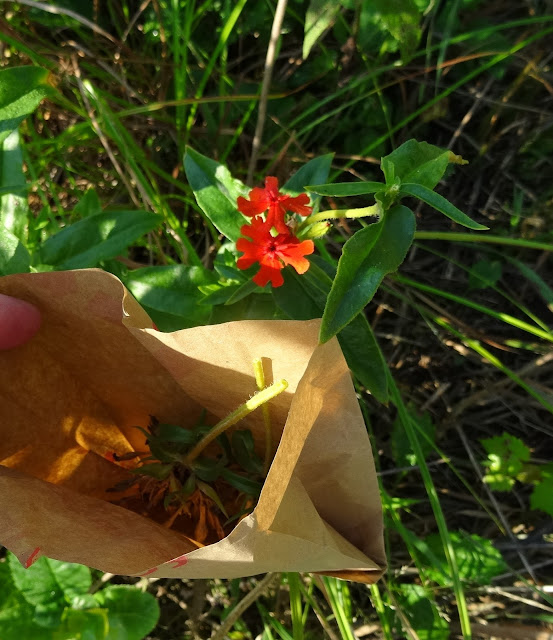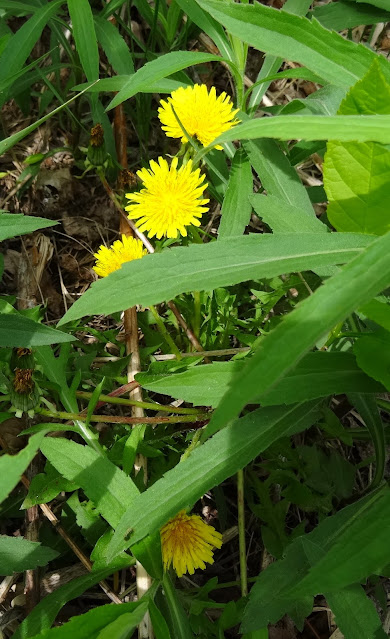10/01/2022
9/06/2022
vivipary = seed heads sprouting
This wildflower was finished blooming and was forming seeds. But its seed head sprouted green leaves! Fascinated, I looked closer. Some of new seeds were actually germinating and sprouting while still in the seed head. Usually, they wait until they are in the perfect place (soil, moisture, temperature, sunlight) to begin new growth. Sometimes you see this while seeds are still inside the fruit, like a tomato or green pepper. In plants, it is called vivipary (Latin for 'live birth') and involves seeds germinating before their determined time. I first learned about this a few years ago when my grandson sent me a photo of a sunflower seed head that was doing the same thing.
8/02/2022
summer native bloomers
Blossoming among the grasses and rushes around the pond are Blue Vervain, Culvers Root, Wild Bergamot, Evening Primrose. Seed heads of Penstemon stand as they dry in the sun.
7/08/2022
5/12/2022
nectar and pollen
9/18/2021
seed harvest
Birds are already pecking out the sunflower seeds (top) and goldenrod flowers are releasing each seed with pappus, a tuft of hair that helps it disperse in breezes (bottom).
8/06/2021
bugs by the pond

6/25/2021
scouring rush
Scouring Rush Equisetum hyemale grows in the wetland around the pond. It is also called 'horsetail'.
6/09/2021
mallow
Small wildflowers grow in the riparian area surrounding the pond. Some are invisible to the casual observer because of their small stature, or because they are hidden by the many taller grasses and reeds.
One of these tiny weedy wildflowers is Common Mallow Malva neglecta, with 5 petals of palest pink with stronger pink stripes.
The leaves resemble geraniums but the two families have different reproductive structures.
Mallow is also called 'Cheeseweed' since each seed looks like a miniature wheel of cheese.
2/05/2021
winter gardening
Read more about the process at https://northerngardener.org/winter-sowing-perennials-works/
2/01/2021
1/28/2021
10/19/2020
seed heads
I have been wandering the riparian buffer and clipping some of the wildflower seed heads to distribute them around the pond. Some native wildflowers exist here already, and we want to spread desirable plants throughout the buffer.
The clipping process is "a few for spreading to make new plants, most left for the birds."
Even after the seeds are gone, the structure of the plant is interesting!
10/05/2020
yellow loosestrife
9/22/2020
bur marigold
Even while fading and going to seed, the Bur Marigolds Bidens cernua nod as their seed load gets heavier. They are called 'Nodding Bur Marigold' for good reason. That makes them sound benign but their middle name 'bur' refers to the hard angled seeds with 4 barbed hooks that give them a free ride on passing animals or people to where they might sprout anew.
9/01/2020
monarch on vervain
The Blue Vervain blossoms have mostly gone to seed. In the buffer around the pond, they've been blooming since mid-July. The flowers of Verbena hastata open one by one from the bottom of spikes held on the crown of the plant. This Monarch butterfly looked for nectar in the few remaining flowers at the top of the spike. Along with butterflies, bees and other insects visit Vervain. Now, the seeds will be food for birds like Cardinals, Sparrows, and Juncos.
6/25/2020
queen anne's lace
Queen Anne's Lace Daucus carota is a member of the carrot family. There are several of these tall striking 'wild carrot' plants in the disturbed area around the pond.
Each bloom is an umbel of small flowers that form a shape like an open umbrella. Its flower looks like poison hemlock or wild parsnip, two plants you want to avoid. The few small magenta flowers in the center help identify Queen Anne's Lace.
(photo left)
It is interesting and pretty, but if allowed to proliferate it can crowd out native wildflowers.
We hope to limit Queen Anne's Lace spread by clipping the flowers just before they go to seed. Meanwhile, we can enjoy the white (sometimes pink-tinged) blossoms.

6/24/2020
full bloom thistle

The Musk Thistle Carduus nutans I've been watching since May is now blooming. The plant is more than 5 feet tall and branched out regally to stand above the other flowers near it.
Several blooms, each opening in their own time, reveal deep magenta color at first. (See 6/7/2020 and 6/17/2020.) Then, as the flower head ripens, it seems pale lavender. The plant flowers over a seven- to nine-week period, and begins to disseminate seed about two weeks after it first blooms.
Note: This is a non-native invasive plant that can compete with native wildflowers, so we will try to control the seeds.
6/22/2020
chamomile
Daisy-like flowers are scattered here and there around the pond. Most are the Ox-eye Daisy Leucanthemum vulgare, a common wild flower.
This flower, German Chamomile Matricaria chamomilla, is another plant grown in some places as a crop. The flowers contain a blue essential oil that is distilled and used in health care and beauty products.
German Chamomile has an upright stem that branches with fine fern-like foliage and multiple flowers that do look like small daisies.
In some places this plant is considered a nuisance weed. We (and the pollinators) enjoy its presence as a bright spot among green wildflowers, grasses, sedges, and rushes circling the pond.






















